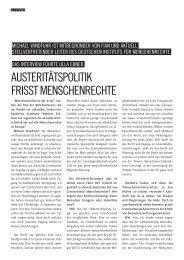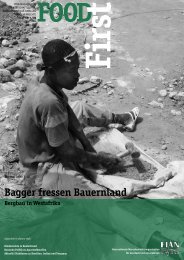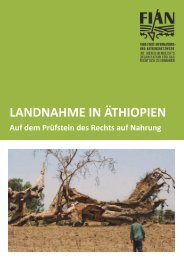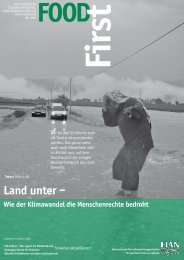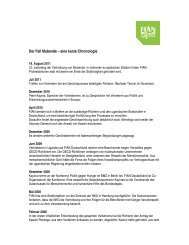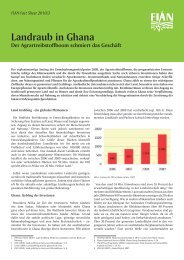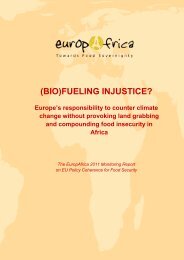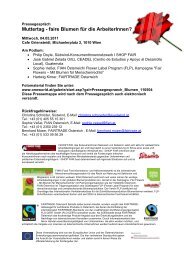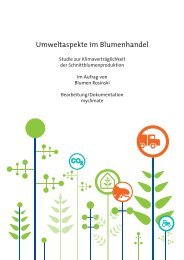Study 3: Ecodestruction and the Right to Food: The Cases of Water ...
Study 3: Ecodestruction and the Right to Food: The Cases of Water ...
Study 3: Ecodestruction and the Right to Food: The Cases of Water ...
Create successful ePaper yourself
Turn your PDF publications into a flip-book with our unique Google optimized e-Paper software.
Starving <strong>the</strong> Future <strong>Study</strong> 3<br />
II. Responding with <strong>Ecodestruction</strong> <strong>to</strong> Nature’s<br />
Blessings: <strong>Water</strong> <strong>and</strong> Biodiversity<br />
A. Basics on <strong>Water</strong><br />
Looking at <strong>the</strong> Earth from outer space one could think that <strong>the</strong> water resources were so plentiful that<br />
<strong>the</strong>y could sustain all life forever. But, almost all <strong>of</strong> Earth's water is <strong>the</strong> salty water <strong>of</strong> <strong>the</strong> oceans. This<br />
water supports an incredible biodiversity <strong>of</strong> marine life, but humans <strong>and</strong> l<strong>and</strong>-dwelling animals cannot<br />
drink it, <strong>and</strong> we cannot water our crops with it. Humans require fresh, clean water <strong>to</strong> drink, <strong>and</strong> can<br />
survive for only about one week without it.<br />
Only a very tiny portion <strong>of</strong> all <strong>the</strong> Earth's water is fresh water, <strong>and</strong> an even smaller amount <strong>of</strong> <strong>the</strong> fresh<br />
water is available <strong>to</strong> us. Most <strong>of</strong> <strong>the</strong> fresh water is locked up in frozen glaciers, in humidity, or fossil<br />
water way deep in <strong>the</strong> Earth. Rivers, lakes <strong>and</strong> wetl<strong>and</strong>s represent only 0.01% <strong>of</strong> freshwater supplies<br />
<strong>and</strong> 1% <strong>of</strong> <strong>the</strong> surface <strong>of</strong> our planet. 4 Although desalination provides <strong>the</strong> possibility <strong>of</strong> producing fresh<br />
water from <strong>the</strong> seas, <strong>the</strong> amount <strong>of</strong> energy required in this process for <strong>the</strong> production <strong>and</strong> distribution<br />
prevent this technology from <strong>of</strong>fering a large scale solution <strong>to</strong> <strong>the</strong> growing scarcity <strong>of</strong> fresh water.<br />
1. Types <strong>of</strong> freshwater systems<br />
Freshwater systems include rivers, lakes <strong>and</strong> wetl<strong>and</strong>s. In addition <strong>to</strong> this surface water, <strong>the</strong>re are<br />
ground water sources. Those sources can be classified in<strong>to</strong> two different categories: <strong>Water</strong> that is<br />
independent <strong>of</strong> <strong>the</strong> normal run<strong>of</strong>f cycle (a minor proportion) <strong>and</strong> water that comes from shallower<br />
aquifers fed by <strong>the</strong> normal run<strong>of</strong>f (which also feeds rivers <strong>and</strong> lake). <strong>The</strong>re is <strong>the</strong>refore an intimate link<br />
between ground <strong>and</strong> surface water sources. In fact, it is <strong>of</strong>ten difficult <strong>to</strong> separate <strong>the</strong> two because <strong>the</strong>y<br />
"feed" each o<strong>the</strong>r. In order <strong>to</strong> better underst<strong>and</strong> this fundamental interdependence, we can describe <strong>the</strong><br />
hydrologic cycle:<br />
As rain or snow falls <strong>to</strong> <strong>the</strong> earth's surface some water runs <strong>of</strong>f <strong>the</strong> l<strong>and</strong> <strong>to</strong> rivers, lakes, streams <strong>and</strong><br />
oceans (surface water). <strong>Water</strong> also can move in<strong>to</strong> those bodies by percolation below ground. <strong>Water</strong><br />
entering <strong>the</strong> soil can infiltrate deeper <strong>to</strong> reach groundwater which can discharge <strong>to</strong> surface water or<br />
return <strong>to</strong> <strong>the</strong> surface through wells, springs <strong>and</strong> marshes. Here it becomes surface water again. And,<br />
upon evaporation, it completes <strong>the</strong> cycle. This movement <strong>of</strong> water between <strong>the</strong> earth <strong>and</strong> <strong>the</strong><br />
atmosphere through evaporation, precipitation, infiltration <strong>and</strong> run<strong>of</strong>f is continuous.<br />
i. Rivers/Streams <strong>and</strong> Lakes<br />
Streams <strong>and</strong> rivers take part in <strong>the</strong> physical <strong>and</strong> chemical cycles that shape our planet <strong>and</strong> allow life <strong>to</strong><br />
exist. <strong>The</strong>y provide different habitats for plants <strong>and</strong> animals, <strong>and</strong> are a source <strong>of</strong> food for animals, plants<br />
<strong>and</strong> human communities. Rivers <strong>and</strong> lakes are nurseries for salmon <strong>and</strong> for many insects. Rivers carry<br />
glacial silt <strong>and</strong> sediments down from <strong>the</strong> mountains, creating rich agricultural l<strong>and</strong>s by depositing it<br />
downstream on its floodplain <strong>and</strong> fertilizing <strong>the</strong> ocean, allowing marine organisms <strong>to</strong> thrive near <strong>the</strong><br />
river's mouth. Even a small mountain stream provides an as<strong>to</strong>nishing number <strong>of</strong> different habitats for<br />
plants <strong>and</strong> animals.<br />
ii. Wetl<strong>and</strong>s<br />
Wetl<strong>and</strong>s is <strong>the</strong> collective term for marshes, swamps, bogs <strong>and</strong> similar areas. It also includes<br />
floodplains <strong>and</strong> flooded forests. Wetl<strong>and</strong>s are found in flat vegetated areas, in depressions <strong>of</strong> <strong>the</strong><br />
l<strong>and</strong>scape <strong>and</strong> between water <strong>and</strong> dry l<strong>and</strong> along <strong>the</strong> edges <strong>of</strong> streams, rivers, lakes <strong>and</strong> coastlines.<br />
Wetl<strong>and</strong> areas can be found in nearly every country <strong>and</strong> climatic zone. Inl<strong>and</strong> wetl<strong>and</strong>s receive water<br />
from precipitation, ground water <strong>and</strong>/or surface water.<br />
FIAN International 103<br />
June 2002



